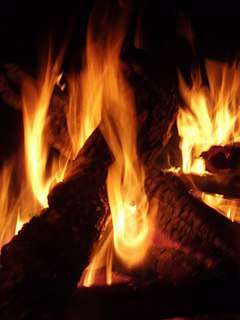Lal Loi
Lal Loi is the Sindhi name for the festival of Lohri.[1][2] Prior to the independence of Pakistan in 1947, Lal Loi was celebrated in some parts of Sindh. On the day of Lal Loi children brought wood sticks from their grand parents and aunties and lit a fire burning the sticks in the night with people enjoying, dancing and playing around the fire.
| Lal Loi (Sindh)(Lohri) | |
|---|---|
 Lal Loi Bonfire | |
| Type | Seasonal, traditional |
| Significance | Midwinter festival, celebration of Winter Solstice |
| Celebrations | Bonfire, song and dance |
| Date | 13 January |
| Related to | Lohri |
Sindhis believe that the focus of Lal Loi should be on getting rid of old belongings and cleansing the mind in readiness of the festival of Tirmoor which is observed the day after Lal Loi by all Sindhis. Tirmoor is the Sindhi name for Makar Sankranti.[3] For Sindhis, Makar Sankranti means worshipping Lord Sun and flying kites.[4]
According to some, not all Sindhis observe Lal Loi [5] and the festival may have been observed by people of Upper Sindh where historically there has been inward migration from Punjab.[6][7][8][9][10] There are also linguistic similarities between the northern area of Sindh with the Punjab region.[11] It is however difficult to establish where Lal Loi was celebrated in Sindh or if it is observed there now. However, the Sindhis community in India celebrate Lal Loi annually where festivals are organised in places such as Indore where the festival is organised by the Sindu Sabha,[12] Mumbai and Udaipur.[13]
In places where Sindhis and Punjabis live in the same city, joint Lal Loi/Lohri festivals are organised.[14]
See also
- Makar Sankranti
- Pongal
- Ahir
- Bhogali Bihu
- Sankranti
- Winter Solstice
- Lohri
References
- "Archived copy". Archived from the original on 14 July 2014. Retrieved 6 February 2014.CS1 maint: archived copy as title (link) Jhuelel Mandir
- Sindhi Rasoi
- J P Vaswani: Destination Happiness
- Nidhin Singhi "Lohri gaiety warms all" Times of India 13 01 2012
- Nidhin Singhi "Lohri gaiety warms all" Times of India 13 01 2012
- Amil Sindhis
- All about Sindhis (Sindhi-Punjabis)
- Kumar, P. Pratap (2014) Contemporary Hinduism
- http://historyofpakistan.kamranweb.com/sindh/history-of-sindh.html
- http://prosody.beckman.illinois.edu/jscole/objects/pubs-sindhi/1_Cole_Sindhi.pdf
- Schimme, Annemarie (1974) Sindhi Literature, Volume 9, Parts 1-2
- Hindustan Times: 12 01 2014
- Udaipur Times, Gaurav Bhandari 13 01 2013
- Merinews: Dr Lalit Kishore 08 01 2014